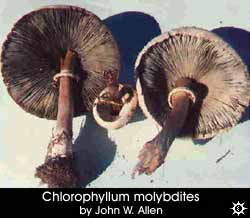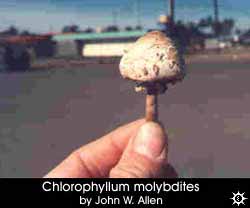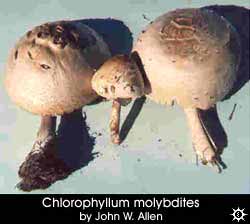|
|
 METHODS OF INGESTION In 1979, J.J. McRoach, a former candidate for the Australian Marijuana Party, described one of his experiences in New South Wales: "No grease in this restaurant - instead brightly painted walls with lots of sunflowers and colorful cushions......all very cool, very laid-back. Walking into the kitchen to suss food situation. Amiable freak cum cook loads me up with a couple of salads. "What brings you to Mullumbimby? he asks. "The mushrooms, I've come for the mushrooms". "Yeah? Well if you like I'll heat up a few for your salad man?" "No, no, that's OK - I'm talking about the psychedelic stuff. Magic Mushrooms..." "So am I - do you still want them on your salad?" "Huh? Oh...sure. Yeah sure, pile 'em on" Psychoactive mushrooms are either eaten fresh (which supposedly produces the most powerful and intensely visual experience) or dried and consumed at a later date. Some users freeze their mushrooms for later use; others put them in capsules for resale and some have put them in jello. Mixing the mushrooms in milkshakes (known as 'mushroom smoothies') or tea are common methods employed by some users who dislike the natural taste of the mushrooms. Cooking the mushrooms in a soup, stew or omelette has been a popular form of consumption by some users in order to alleviate the acrid taste of the mushrooms. One reported method of consumption by users in the Southeastern United States who consume Psilocybe cubensis claims that one may "boil the mushrooms in water to remove the active ingredients (which are soluble in hot water)" and then "use the water to prepare foods such as rice or soup, and discard the remains of the mushrooms." Adding further, the author of this report claimed that "this is the basic recipe for hallucinogenic beverages such as magic Kool-aid." Chocolate and honey are also employed by recreational users for use with their mushrooms. In 1989, Roy Watling reported that during his stay in Queensland in l974, he "saw many `foraying' groups of young people looking for Psilocybe [species] in fields, and was told by one user that Psilocybe was packed in honey to preserve, transport and export." Honey is more frequently used in New Zealand for actual storage. According to some mushroom enthusiasts, mushrooms in honey preserve their potency much better than those which are dried or frozen, especially if placed in honey just after being picked. Other consumers claim that this is not a good method because bacteria may form in this mixture with age (see Ott, 1993). It should be mentioned that both honey and chocolate were served with mushrooms during Aztec ceremonies, coronations and festivals, prior to and during the Spanish conquest of the Mesoamerica. IDENTIFICATION OF AUSTRALIAN PSYCHOACTIVE FUNGI 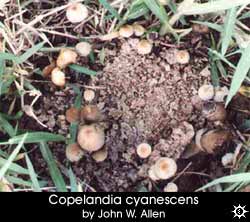 In 1958, Aberdeen and Vogt documented Psilocybe cubensis as the first known psychoactive mushroom reported from Australia. This occurred when several scientists were conducting a study of the chemical properties of Panaeolus ovatus, a mushroom which was reported as being responsible for a number of accidental intoxications in Australia. These scientists who were commissioned to undertake this chemical investigation, had assumed that several mushroom poisoning incidents in Australia were not caused by Panaeolus ovatus, but instead were due to the accidental consumption of Psilocybe cubensis. They cited several reasons which led them to that conclusion. Later, however, Dr. Ronald Southcott, a physician and mycologist suggested that some species of Panaeolus were probably the cause of what became known in the newspapers as the `hysteria' outbreaks, while an American cultivator of psychoactive mushrooms Dr. Steven H. Pollock (1977-1978) believed that Copelandia cyanescens was the mushroom species responsible for at least some of the `Hysteria' intoxications which were attributed to the ingestion of Panaeolus ovatus which is a mushroom now known to be synonymous with Panaeolus antillarum. These latter species of Panaeolus resemble Copelandia cyanescens and sometimes all three of these species are know to occur in the same dung-heap of manure.
In 1958, Aberdeen and Vogt documented Psilocybe cubensis as the first known psychoactive mushroom reported from Australia. This occurred when several scientists were conducting a study of the chemical properties of Panaeolus ovatus, a mushroom which was reported as being responsible for a number of accidental intoxications in Australia. These scientists who were commissioned to undertake this chemical investigation, had assumed that several mushroom poisoning incidents in Australia were not caused by Panaeolus ovatus, but instead were due to the accidental consumption of Psilocybe cubensis. They cited several reasons which led them to that conclusion. Later, however, Dr. Ronald Southcott, a physician and mycologist suggested that some species of Panaeolus were probably the cause of what became known in the newspapers as the `hysteria' outbreaks, while an American cultivator of psychoactive mushrooms Dr. Steven H. Pollock (1977-1978) believed that Copelandia cyanescens was the mushroom species responsible for at least some of the `Hysteria' intoxications which were attributed to the ingestion of Panaeolus ovatus which is a mushroom now known to be synonymous with Panaeolus antillarum. These latter species of Panaeolus resemble Copelandia cyanescens and sometimes all three of these species are know to occur in the same dung-heap of manure.In l970, twelve years after Psilocybe cubensis was identified on the Australian continent, two other scientists Picker and Rickards, 1970) reported that they had found psilocybine, but no psilocine, in specimens of Australian collections of P. subaeruginosa. This second record of the presence of hallucinogenic mushrooms in Australia and the development of recreational ingestion of psychoactive visionary mushrooms among drug users in Australia during the l960's and l970's prompted a number of scientific and governmental studies of the Australian mycoflora (Perkel et al., 1970). The general objective was to identify the occurrence of other suspected psychoactive mushrooms which were indigenous or naturalized in this large country. 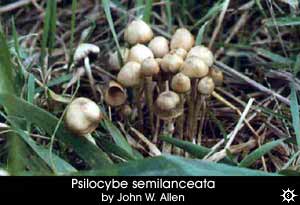 Dr. Malcolm Hall (1973), reported the occurrence of Psilocybe collybioides and Psilocybe subaeruginosa from Tasmania, Psilocybe cubensis from Queensland, and Copelandia cyanescens from Australia, noted that at the same time, his investigations of the Panaeolus species were incomplete. In addition, mycologist C. J. Shepherd, along with Dr. Hall (Shepherd & Hall, 1973) listed the following species as mind-altering agents which were possibly being ingested by collectors of Australia's wild psychoactive fungi: Copelandia cyanescens, Psilocybe collybioides, Psilocybe cubensis, Psilocybe subaeruginosa, Psilocybe semilanceata, Gymnopilus spectabilis and Panaeolus subbalteatus. The latter occurs naturally in Australia, is psychoactive, and is known to be used as a recreational drug in the Pacific Northwest of the United States. In 1974, Dr. Southcott (1974), reviewed the literature and reported that P. cubensis, P. subaeruginosa, P. collybioides, C. cyanescens, and P. foenisecii had apparently been responsible for a number of accidental mushroom poisonings (i.e., psychologically disturbing experiences) which occurred in Australia between l941 to l973. And again Cribb and Cribb (1975) also reported the occurrence in Australia of Psilocybe cubensis.
Dr. Malcolm Hall (1973), reported the occurrence of Psilocybe collybioides and Psilocybe subaeruginosa from Tasmania, Psilocybe cubensis from Queensland, and Copelandia cyanescens from Australia, noted that at the same time, his investigations of the Panaeolus species were incomplete. In addition, mycologist C. J. Shepherd, along with Dr. Hall (Shepherd & Hall, 1973) listed the following species as mind-altering agents which were possibly being ingested by collectors of Australia's wild psychoactive fungi: Copelandia cyanescens, Psilocybe collybioides, Psilocybe cubensis, Psilocybe subaeruginosa, Psilocybe semilanceata, Gymnopilus spectabilis and Panaeolus subbalteatus. The latter occurs naturally in Australia, is psychoactive, and is known to be used as a recreational drug in the Pacific Northwest of the United States. In 1974, Dr. Southcott (1974), reviewed the literature and reported that P. cubensis, P. subaeruginosa, P. collybioides, C. cyanescens, and P. foenisecii had apparently been responsible for a number of accidental mushroom poisonings (i.e., psychologically disturbing experiences) which occurred in Australia between l941 to l973. And again Cribb and Cribb (1975) also reported the occurrence in Australia of Psilocybe cubensis.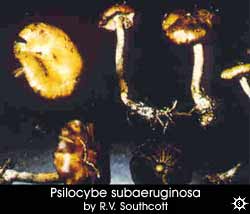 In 1978, a taxonomic investigation of Australian mushrooms was later carried out by the renown Mexican mycologist, Dr. Gastón Guzmán and Dr. Roy Watling (1978), who concluded that the identification of P. collybioides, by Dr. Hall and Dr. Southcott in 1974, was inexact (see Table 1). In the same year, Guzmán and Watling also suggested that the non-hallucinogenic species P. coprophila, a dung inhabiting fungi found in Australia, might possibly be hallucinogenic (see identification section). In addition, they verified the occurrence of P. foenisecii (another non-hallucinogenic species, see Allen and Merlin, 1992b), P. semilanceata, and P. subaeruginosa in Australia, and suggested that Psilocybe kumaenorum, a species previously recognized only from New Guinea, might also occur in Australia because of the existence of the appropriate ecological conditions along the Gold Coast area of New South Wales.
In 1978, a taxonomic investigation of Australian mushrooms was later carried out by the renown Mexican mycologist, Dr. Gastón Guzmán and Dr. Roy Watling (1978), who concluded that the identification of P. collybioides, by Dr. Hall and Dr. Southcott in 1974, was inexact (see Table 1). In the same year, Guzmán and Watling also suggested that the non-hallucinogenic species P. coprophila, a dung inhabiting fungi found in Australia, might possibly be hallucinogenic (see identification section). In addition, they verified the occurrence of P. foenisecii (another non-hallucinogenic species, see Allen and Merlin, 1992b), P. semilanceata, and P. subaeruginosa in Australia, and suggested that Psilocybe kumaenorum, a species previously recognized only from New Guinea, might also occur in Australia because of the existence of the appropriate ecological conditions along the Gold Coast area of New South Wales.Furthermore, Guzmán and Watling (1958) also reported the discovery of three additional Psilocybe species and suggested that these newly described species might also be hallucinogenic. Their assumption was based on the following macroscopic characteristics which they observed in freshly collected specimens: Psilocybe eucalypta, which exhibits an "intense bluing at the base of the stipe;" Psilocybe australiana, which "when handled exhibited much bluing at the base of the stipe;" and Psilocybe tasmaniana, which "exhibited a blue-green tone at the base of the stipe." All three of these species are similar to P. subaeruginosa; however, P. australiana and P. eucalypta are very similar to each other, while P. tasmaniana resembles P. coprophila (Johnston & Buchanan, 1995). All three of these species are also closely aligned with Psilocybe cyanescens. Undaunted by any taxonomic confusion and alarmed by the increasing use of naturally abundant, psilocybin mushrooms in the l970's, a group of Australian chemists then sought to develop a more accurate and efficient method to determine the exact amounts of hallucinogenic compounds extracted from confiscated fungal specimens. Using extractions from dried specimens of Psilocybe subaeruginosa, these chemists eventually produced a procedure that provides excellent quantification for psilocin and psilocybin following a simple extraction involving homogenization of the dried mushroom in methanol (Perkel et al., 1980). OTHER SUSPECTED AUSTRALIAN PSYCHOACTIVE FUNGI 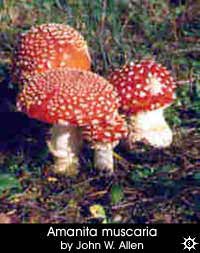 Amanita muscaria and a related species Amanita pantherina are used in the United States as a recreational drug source. The former species which is used traditionally by several aborigine tribal groups in Siberia and some members of the Ojibway clan in Northern Michigan, United States and Ontario, Canada, may also be the "Soma" drug-plant of the Rig Veda (the ancient Hindu scriptures). Dr. Malcolm C. Hall, formerly of the Commonwealth Police force of Canberra, Australia, referred to a few instances of its use by members of the drug subculture in New Zealand. Both of these species contain ibotenic acid and muscimol, two psychoactive substances. Both of these Amanita mushrooms occur in Australia and in New Zealand, and have been used for their psychoactive effect.
Amanita muscaria and a related species Amanita pantherina are used in the United States as a recreational drug source. The former species which is used traditionally by several aborigine tribal groups in Siberia and some members of the Ojibway clan in Northern Michigan, United States and Ontario, Canada, may also be the "Soma" drug-plant of the Rig Veda (the ancient Hindu scriptures). Dr. Malcolm C. Hall, formerly of the Commonwealth Police force of Canberra, Australia, referred to a few instances of its use by members of the drug subculture in New Zealand. Both of these species contain ibotenic acid and muscimol, two psychoactive substances. Both of these Amanita mushrooms occur in Australia and in New Zealand, and have been used for their psychoactive effect. 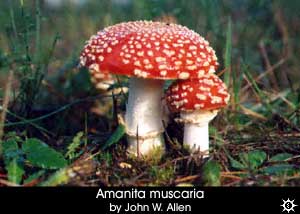 The major limitations upon their use, particularly the use of A muscaria, is the severe nausea and violent vomiting which follow ingestion. In New Zealand, attempts have been made to reduce this effect by peeling the red `skin' from the cap, and by drying the mushrooms in the sun for several days. These preparation methods have not proven to be successful, and hence the mushroom is ingested only by the poorly informed, although it is quite wide spread in its distribution. In fact, the consequences of ingestion are so unpleasant that one is led to speculate that the A. muscaria employed by Siberian tribesmen contains a different balance of chemicals to that found in New Zealand, which almost no users are prepared to consume more than once. It is also worth noting that ibotenic acid is a potent neurotoxin, causing neuronal death via a mechanism known as excito-toxicity (Jansen, Per. Comm., 1989).
The major limitations upon their use, particularly the use of A muscaria, is the severe nausea and violent vomiting which follow ingestion. In New Zealand, attempts have been made to reduce this effect by peeling the red `skin' from the cap, and by drying the mushrooms in the sun for several days. These preparation methods have not proven to be successful, and hence the mushroom is ingested only by the poorly informed, although it is quite wide spread in its distribution. In fact, the consequences of ingestion are so unpleasant that one is led to speculate that the A. muscaria employed by Siberian tribesmen contains a different balance of chemicals to that found in New Zealand, which almost no users are prepared to consume more than once. It is also worth noting that ibotenic acid is a potent neurotoxin, causing neuronal death via a mechanism known as excito-toxicity (Jansen, Per. Comm., 1989).CHEMICAL IDENTIFICATION OF AUSTRALIAN HALLUCINOGENIC FUNGI While concerned Australian mycologists have long been interested in the accidental ingestion of poisonous mushrooms by unsuspecting foragers, they have been well aware since the late l930's, that some mushrooms induce strange psychological reactions in humans when eaten, and that individuals who had consumed these mushrooms had also reported queer disturbances of vision. 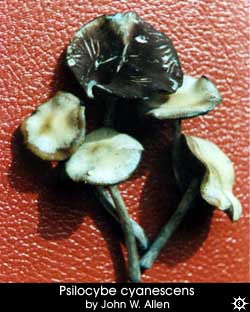 The earliest report of a suspected hallucinogenic intoxication from a mushroom in Australia occurred in the early l930's, but the first mycological identification of a mind-altering fungus in the country did not occur until more then twenty years later when two mycologists first reported their description of Psilocybe cubensis collected from Springbrook, Australia.
The earliest report of a suspected hallucinogenic intoxication from a mushroom in Australia occurred in the early l930's, but the first mycological identification of a mind-altering fungus in the country did not occur until more then twenty years later when two mycologists first reported their description of Psilocybe cubensis collected from Springbrook, Australia.Psychoactive mushrooms "containing psilocybine, psilocine, or related alkaloids with an indole nucleus and producing, by an oxidative process, a blue pigment," are known to occur in at least 12 different genera of fungi, primarily belonging to various species of Psilocybe and Panaeolus. Additionally, other genera also contain the alkaloids psilocine and psilocybine. The principle agents found in these fungi are indoles known as psilocybine and its dephosphorylated derivative psilocine (Singer, 1978). References to the hypothesis which suggests "that the activity of psilocybine may be associated with its structural similarity to serotonin," which is a neurotransmitter has been well documented (Hofmann, 1980). It should also be noted that the presence of both psilocybine and psilocine may be accompanied by their monoanalogue baeocystine and its bis-demethylated analogue norbaeocystine which are both known to be psychoactive. Many of these species are also known to contain 5-hydroxytryptamine (serotonin), tryptophan, and other related indole compounds. Psilocybine is water soluble, while psilocine is not and both may be extracted from the mushrooms with methanol. PSYCHOACTIVE EFFECTS OF PSILOCYBIAN MUSHROOMS Symptoms produced by eating fresh hallucinogenic mushrooms begin to occur within 15 to 30 minutes after ingestion (or from 5 to 10 minutes when prepared in the form of tea or soup). Symptoms persist for up to four to six hours after ingestion. In 1960, Clinical effects for psilocybine intoxication in humans was reported as being Hollister et al., 1962): "0-30 minutes - Slight nausea, giddiness (light-headed), abdominal discomfort, weakness, muscle aches and twitches, shivering, anxiety, restlessness, and a numbness of lips.For comparison with the clinical experience described above, the following is an excerpt from one of R. Gordon Wasson's experience with psilocybin mushrooms: "The mushrooms take effect differently with different persons. For example, some seem to experience only a divine euphoria, which may translate itself into uncontrollable laughter. In my case I experienced hallucinations. What I was seeing was more clearly seen than anything I had seen before. At last I was seeing with the eye of the soul, not through the coarse lenses of my natural eyes. Moreover, what I was seeing was impregnated with weighty meaning: I was awe-struck." PSILOCYBIAN MUSHROOM POISONING Ancient or historic evidence of cerebral mycetisms induced by the accidental ingestion of hallucinogenic mushrooms has been documented in various parts of the world. Early reports of intoxication attributed to the unintentional consumption of these fungi come from China in the 3rd century A.D., Japan during the eleventh century A.D., Great Britain in both l799 and in the early l800's, in the United States around the early l900's and in France in the early l960's. It is of interest to note a report from Japan that there were over 366 accidental ingestions of psilocybin mushrooms reported in l929; these incidents were reported by people foraging for wild edible mushrooms. In Africa during the l940's a number of unintentional intoxications occurred when mind-altering mushrooms were inadvertently sold as a source of food by children in public markets. It must be noted that outside of a few intoxications caused by Psilocybe cubensis (in Africa), and one caused by Psilocybe semilanceata (in England in the late 1700's), the majority of all intoxications which occurred prior to the recreational use of these species, were caused by various species of Panaeolus with the exception of Japan and the Northeastern United States, where some of the inebriations were the result of ingesting various species of Gymnopilus. Published reports describing symptoms attributed to Panaeolus intoxications, were often written in a similar manner. Subjective effects included:
In a paper published in 1958, Dr. Sam Stein briefly mentioned similar observations when Panaeolus and Psilocybe fungi were used in the treatment of a single patient. Mushroom extracts used by Dr. Stein were obtained from dried specimens of Panaeolus venenosus (=Panaeolus subbalteatus), and Psilocybe caerulescens. Further investigations were carried out in 1959 by Stein and some of his colleagues who revealed that the subjective effects caused by the ingestion of Panaeolus species were more tranquil and less hallucinogenic than the effects produced by the ingestion of certain species of Psilocybe. The fear of poisoning by physically toxic mushrooms is the main cause of mycophobia (a fear of mushrooms) throughout the world. Many of the deadly poisonous species of mushrooms macroscopically resemble some of the hallucinogenic mushrooms in the genus Psilocybe. For example, three species of deadly poisonous Galerina's, and Conocybe filaris, which are extremely poisonous mushrooms, are commonly found in mulched gardens in the Pacific Northwest of the United States and other regions of the world, and have been observed sharing the same habitat as Psilocybe baeocystis, Psilocybe cyanescens, and Psilocybe stuntzii. Another example of misidentification involves Chlorophyllum molybdites also known as "green gills" or "Morgans" Lepiota. According to Stephen Peele, curator of the Florida Mycology Research Center, it is often picked in Florida and mistaken for Psilocybe cubensis (personal communication to J.W. Allen). Chlorophyllum molybdites is considered toxic but not deadly. This species is common in Australia and may occasionally be mistaken as Psilocybe cubensis. Peele also claimed that in Tampa, Florida, over 90% of all mushroom poisonings were the result of ingesting C. molybdites. While two children in California developed a "mydriasis-fever-convulsions" syndrome after ingesting mushrooms taken from a lawn habitat, another in the state of Washington was reported to have died due to complications following the suspected consumption of hallucinogenic mushrooms. Also, three children were reportedly mildly poisoned after accidentally grazing on lawn specimens of Panaeolina foenisecii, however, in a recent study of the literature, it was suggested by Allen and Merlin (1992b), that this species is not psychoactive. A sixteen year old girl from Whidbey Island, Washington did die in December l981 after accidentally picking and eating several fresh specimens of Galerina autumnalis. She and her two teenage male companions had assumed that they ingested Psilocybe mushrooms. Unfortunately, the youths did not report their misguided consumption of the deadly mushroom to the proper medical authorities for two days due to their fear of prosecution. It is thus possible that young children may be susceptible to convulsions following the consumption of some varieties of psilocybian mushrooms. However, the world renown Mazatec curandera María Sabina and her sister María Ana, made famous by the writings of the Wassons' and others, both first ate these hallucinogenic mushrooms somewhere between the ages of 7-9, and María Sabina continued to do so for over 70 years without any apparent physical illness. Also, R. Gordon Wasson and his wife Valentina, allowed their 19-year-old daughter Masha to eat mushrooms apparently without ill effect. Even a professional mycologist must be quite careful when deciding which wild mushrooms may be safe for human consumption. For example, some mushrooms, which are common and edible in Europe, can be deadly poisonous or harmful enough to cause physical damage when collected and consumed in the United States, Canada, or even Australia. In 1978, Jonathan Ott reported that the "Ld50 (lethal dosage) in mice for psilocybin has been determined to be 280 mg/kg, oral ingestion", thereby assuming that a person of average weight (i.e. 70 kg/155 lb) person, "would have to ingest l9.6 grams of [the extracted chemical] psilocybin to produce death." However, in 1989, Dr. Karl L. R. Jansen at the University of Auckland stated that he believes that "the LD50 (the dose at which 50% of a sample will die) has been determined as 280 mg/kg in mice. However, it is not valid to calculate the LD50 for humans by a simple percentage/weight calculation. Mice and humans have very different metabolic rates and dispose of drugs in different ways. It is unlikely that even a large number of psilocybine mushrooms would not be toxic in humans, but we cannot suggest an exact figure from data based on rodent studies."
|


|
|
|
|
|
|
